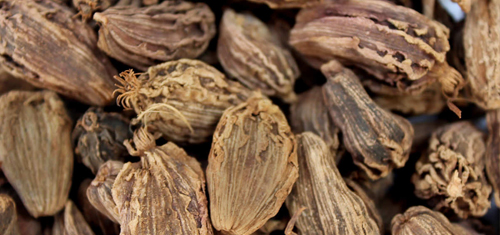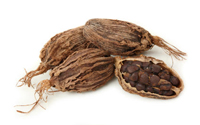Big Cardamom
Big Cardamom
Pronounced: KAR-duh-muhm

Big cardamom, also known as Black cardamom, hill cardamom, Bengal cardamom, greater cardamom, Indian cardamom, Nepal cardamom, winged cardamom, or brown cardamom, comes from either of two species in the family Zingiberaceae. Its seed pods have a strong camphor-like flavor, with a smoky character derived from the method of drying.
What Is Big Cardamom?
 Big Cardamom is roughly 2.5 to 3 cm in length, Big Cardamom pods are dark brown to black in color and have a tough, dried, wrinkly skin. They are highly aromatic but not as much as Green Caradmom. Big Cardamom is dried over a smoke fire and therefore has a distinct smokey aroma. The seeds have sweetish, smokey flavor when bitten into.
Big Cardamom is roughly 2.5 to 3 cm in length, Big Cardamom pods are dark brown to black in color and have a tough, dried, wrinkly skin. They are highly aromatic but not as much as Green Caradmom. Big Cardamom is dried over a smoke fire and therefore has a distinct smokey aroma. The seeds have sweetish, smokey flavor when bitten into.
Plant and Cultivation
Large cardamom is a seophyte, i.e a shade-loving plant. It is a crop of humid sub-tropics and a semi-evergreen plant. It is naturally found in the steep hills of eastern sub-Himalayan region which receive a well-distributed rainfall spread around 200 days with a total of about 3,000–3,500mm/year. Large cardamom grows up to 600–2,350m above mean sea level. Large cardamom is commercially cultivated in lower altitudes of cooler areas and higher altitudes of warmer areas. Cardamom plants remain dormant during winters and it can withstand up to 2°C but the plant is susceptible to frost injury.
The flower bud differentiation occurs from August in lower altitudes to October in higher altitudes. The initiation of flower buds occur before winter on lower elevations but further development takes place only after the lapse of cold period in early-March. On the other hand, in higher elevations, the flower-bud initiation and development occurs post-winter in Arpil–May resulting in late flowering by at least 2–3 months compared to plants grown at lower elevations. Rains during flowering is detrimental, as it hampers foraging activity of the pollinating bees, affecting the sensitive flowers and resulting in poor capsule setting and barren spikes. Large cardamom requires moist but well-drained, loose, slightly acidic, sandy loam to loamy soils. Ideal pH is 4.5–6.0.
Black cardamom is harvested much later than its green counterpart and its flavour is distinctively different from the green variety. Fruit bearing clumps are cleaned by removing diseased and damaged shoots. Afterwards, the fruit bearing spikes are harvested using a sharp-edged knife. Generally, harvesting is done during August–September at low and mid altitudes and November–December at high altitudes. Black cardamom is often dried by exposing the pods to intense heat through placing them over a fire pit. This can produce a strong Smokey flavor. Big cardamom plants are ready for harvesting within two or three years after planting in the main field. But plants start heavy yield from fourth year onwards.
Description
Big cardamom is 4 to 6 times the size of the common small cardamom. There are many distinct species of black cardamom, ranging in pod size from 2 cm to more than 5 cm, with different tastes. Its flavour, aroma and other qualities are quite different from small cardamom. Especially, it has a distinctly more astringent aroma, though not bitter, with coolness similar to mint.
Big Cardamom seeds contain 3% of an essential oil, which is dominated by 1,8-cineol (typically 70%). Smaller and variable amounts of α-terpinyl acetate, limonene, terpinene, terpineol and sabinene. The pericarp contains small amount (0.2%) of essential oil, with a much reduced 1,8-cineol fraction compared to the seed oil. On the other hands, it ontains a few percent of sesquiterpenoids (spathulenol, germ¬acrene D, β-selinene). The brown colour of the pericarp is attributed to 0.1% antho¬cyanines (cyanidin-3-glucosid, cyanidin-3,5-diglucosid); similar compounds make for the red colour of some onion cultivars.
Producing Countries of Big Cardamom
Cardamom is generally produced in the tropical regions of the world. Major producing countries of cardamom in the world are Guatemala, India, Srilanka, Iran, Tanzania etc. However, major production is concentrated in Guatemala and India. Although there are no official estimates available, world cardamom production is estimated to be over 55000 MT. Of the total, Guatemala accounts for nearly30000 MT following by India with about 15000-18000 MT annually.
Consuming Countries of Big Cardamom
Consumption of cardamom has sharply increased throughout the world during the last two decades. The major consuming countries of cardamom are the Middle Eastern countries, India, Pakistan, European countries, the US, and Japan. Middle Eastern countries such as Saudi Arabia and the United Arab Emirates, and South-East Asian countries such as India, etc., account for more than 60% of the world’s consumption. Saudi Arabia is the single largest importer of Cardamom in the world, followed by Kuwait. The list of countries / territories that are the major importers is as follows: Saudi Arabia ,Kuwait ,UAE ,USA ,Japan ,Pakistan ,U.K ,Malaysia ,Israel ,Australia ,Canada and South Africa.
